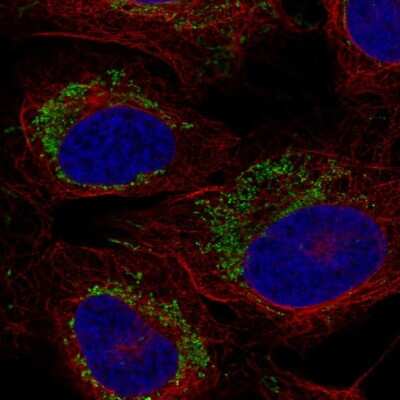CCR7 Antibody
Novus Biologicals, part of Bio-Techne | Catalog # NBP2-58753

Key Product Details
Species Reactivity
Validated:
Human
Applications
Immunocytochemistry/Immunofluorescence, Single Cell Western
Label
Unconjugated
Antibody Source
Polyclonal Rabbit IgG
Concentration
Concentrations vary lot to lot. See vial label for concentration. If unlisted please contact technical services.
Product Summary for CCR7 Antibody
Immunogen
This antibody was developed against a recombinant protein corresponding to the following amino acid sequence: GVKFRNDLFKLFKDLGCLSQEQLRQWSSCRHIRRSSMSVEAETTTTFS
Reactivity Notes
Mouse 83%, Rat 85%
Clonality
Polyclonal
Host
Rabbit
Isotype
IgG
Scientific Data Images for CCR7 Antibody
Immunocytochemistry/Immunofluorescence: CCR7 Antibody [NBP2-58753] - Staining of human cell line U-2 OS shows localization to mitochondria. Antibody staining is shown in green.
Applications for CCR7 Antibody
Application
Recommended Usage
Immunocytochemistry/Immunofluorescence
0.25-2 ug/ml
Application Notes
ICC/IF Fixation Permeabilization: Use PFA/Triton X-100.
Please Note: Optimal dilutions of this antibody should be experimentally determined.
Formulation, Preparation, and Storage
Purification
Affinity purified
Formulation
PBS (pH 7.2) and 40% Glycerol
Preservative
0.02% Sodium Azide
Concentration
Concentrations vary lot to lot. See vial label for concentration. If unlisted please contact technical services.
Shipping
The product is shipped with polar packs. Upon receipt, store it immediately at the temperature recommended below.
Stability & Storage
Store at 4C short term. Aliquot and store at -20C long term. Avoid freeze-thaw cycles.
Background: CCR7
The primary role of the CCR7/CCL19/CCL21 chemokine signaling axis is homing T cells and DCs to lymph nodes and lymphoid tissues to initiate an immune response (1,2,5,6). In the context of cancer, the CCR7 signaling axis appears to have two opposing roles (2). Downregulation of CCR7 on CD8+ T cells contributes to effector cell migration and anti-cancer activities via cytotoxic tumor-infiltrating lymphocytes (2). However, upregulation of CCR7 by cancer cells can result in cancer cell migration and metastasis (2). Overexpression of CCR7 has been implicated in a variety of cancers including breast, cervical, gastric, head and neck cell carcinoma, and prostate (1,2,7). Studies in breast cancer have found that hypoxia increases CCR7 expression, and this activation can affect cancer cell invasion, extravasation, proliferation, angiogenesis, and metastasis through induction of multiple signaling transduction pathways such as PI3K/AKT, MAPK, and JAK/STAT (5,7).
Given its important role in inflammation and immune response, several strategies have been employed to target the CCR7 signaling axis for cancer immunotherapy (2). Some cancer immunotherapies under investigation include intra-tumoral administration of CCL19 and CCL21, introduction of patient-derived cells transfected to express CCR7 or its ligands, and vaccines (2). Further interrogation of CCR7/CCL19/CCL21 signaling axis is required to develop better therapeutic strategies for cancer treatment.
References:
1. Comerford, I., Harata-Lee, Y., Bunting, M. D., Gregor, C., Kara, E. E., & McColl, S. R. (2013). A myriad of functions and complex regulation of the CCR7/CCL19/CCL21 chemokine axis in the adaptive immune system. Cytokine & growth factor reviews, 24(3), 269-283. https://doi.org/10.1016/j.cytogfr.2013.03.001
2. Salem, A., Alotaibi, M., Mroueh, R., Basheer, H. A., & Afarinkia, K. (2021). CCR7 as a therapeutic target in Cancer. Biochimica et biophysica acta. Reviews on cancer, 1875(1), 188499. https://doi.org/10.1016/j.bbcan.2020.188499
3. Yan, Y., Chen, R., Wang, X., Hu, K., Huang, L., Lu, M., & Hu, Q. (2019). CCL19 and CCR7 Expression, Signaling Pathways, and Adjuvant Functions in Viral Infection and Prevention. Frontiers in cell and developmental biology, 7, 212. https://doi.org/10.3389/fcell.2019.00212
4. Uniprot (P32248)
5. Korbecki, J., Grochans, S., Gutowska, I., Barczak, K., & Baranowska-Bosiacka, I. (2020). CC Chemokines in a Tumor: A Review of Pro-Cancer and Anti-Cancer Properties of Receptors CCR5, CCR6, CCR7, CCR8, CCR9, and CCR10 Ligands. International journal of molecular sciences, 21(20), 7619. https://doi.org/10.3390/ijms21207619
6. Sanchez-Sanchez, N., Riol-Blanco, L., & Rodriguez-Fernandez, J. L. (2006). The multiple personalities of the chemokine receptor CCR7 in dendritic cells. Journal of immunology (Baltimore, Md. : 1950), 176(9), 5153-5159. https://doi.org/10.4049/jimmunol.176.9.5153
7. Rizeq, B., & Malki, M. I. (2020). The Role of CCL21/CCR7 Chemokine Axis in Breast Cancer Progression. Cancers, 12(4), 1036. https://doi.org/10.3390/cancers12041036
Alternate Names
BLR2, CC-CKR-7, CCR7, CD197, CDw197, CMKBR7, EBI1
Gene Symbol
CCR7
Additional CCR7 Products
Product Documents for CCR7 Antibody
Product Specific Notices for CCR7 Antibody
This product is for research use only and is not approved for use in humans or in clinical diagnosis. Primary Antibodies are guaranteed for 1 year from date of receipt.
